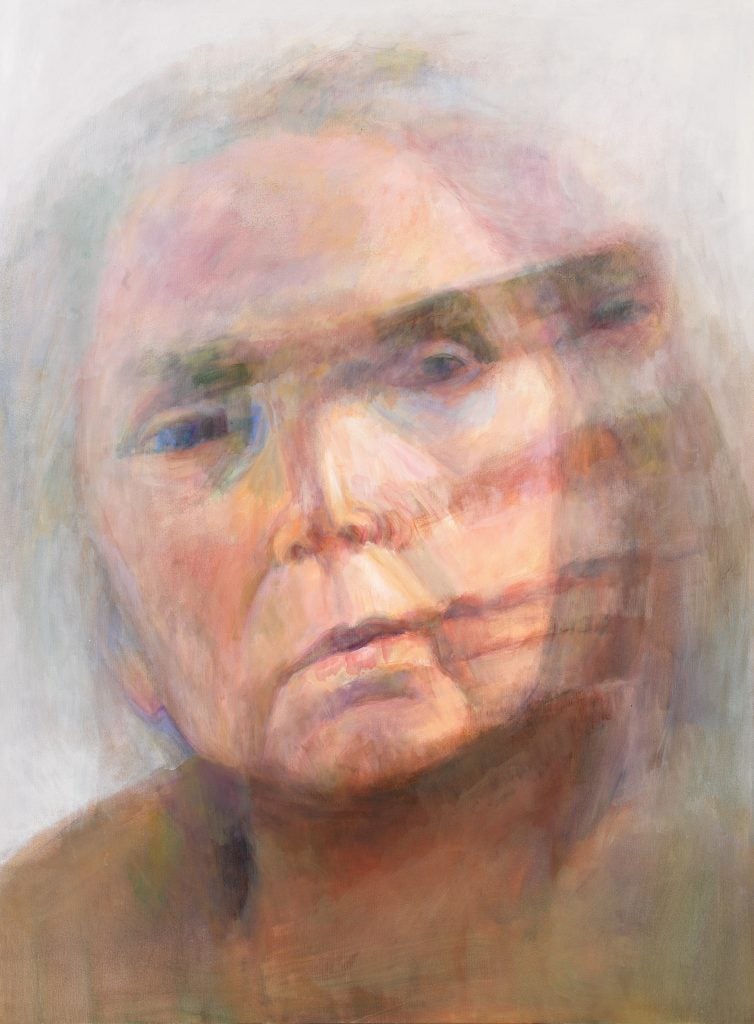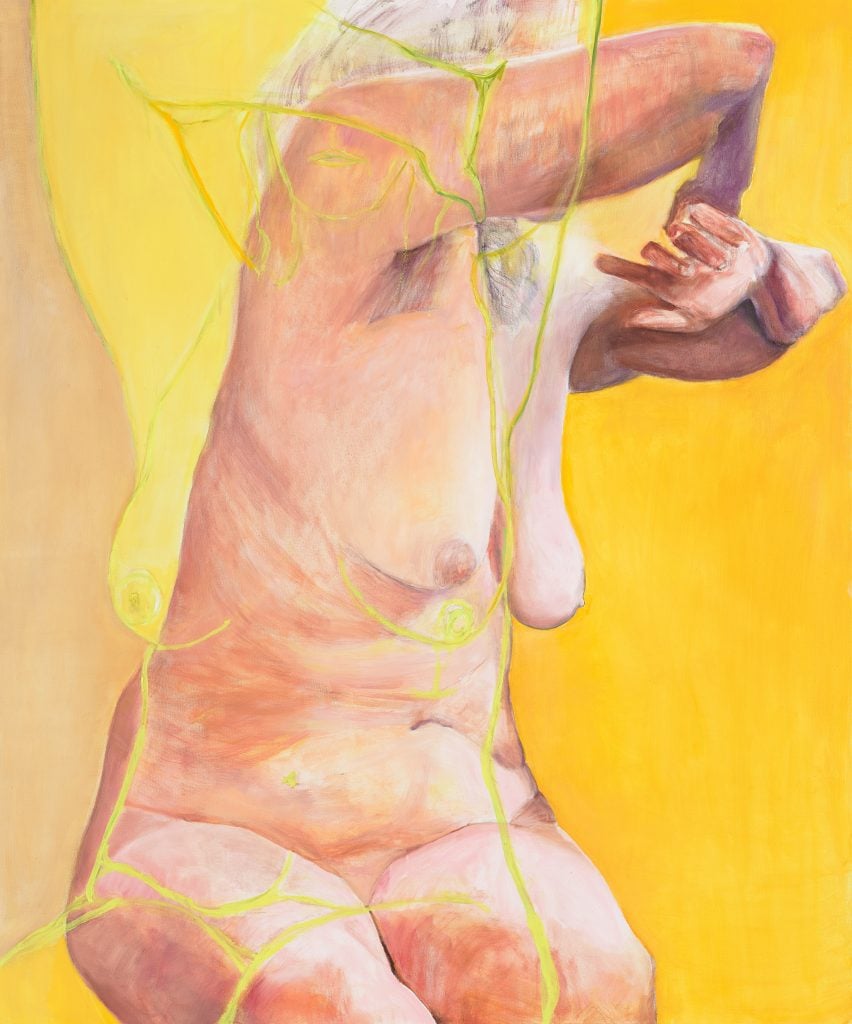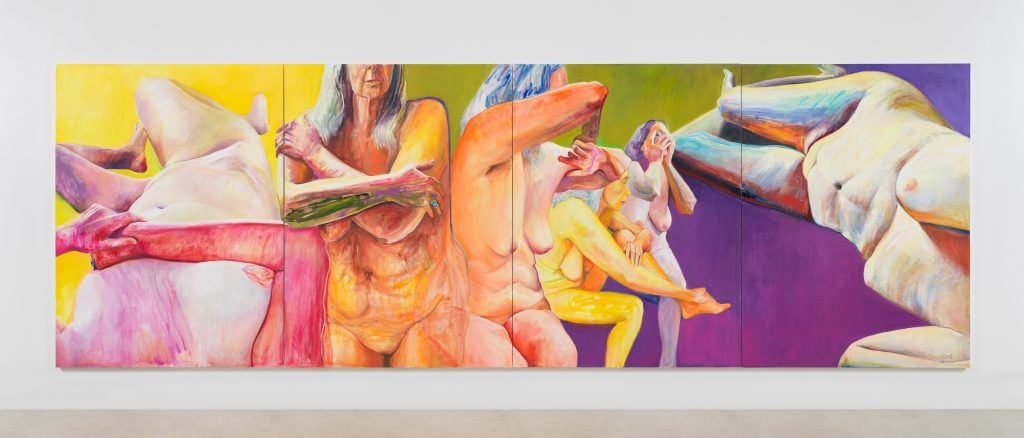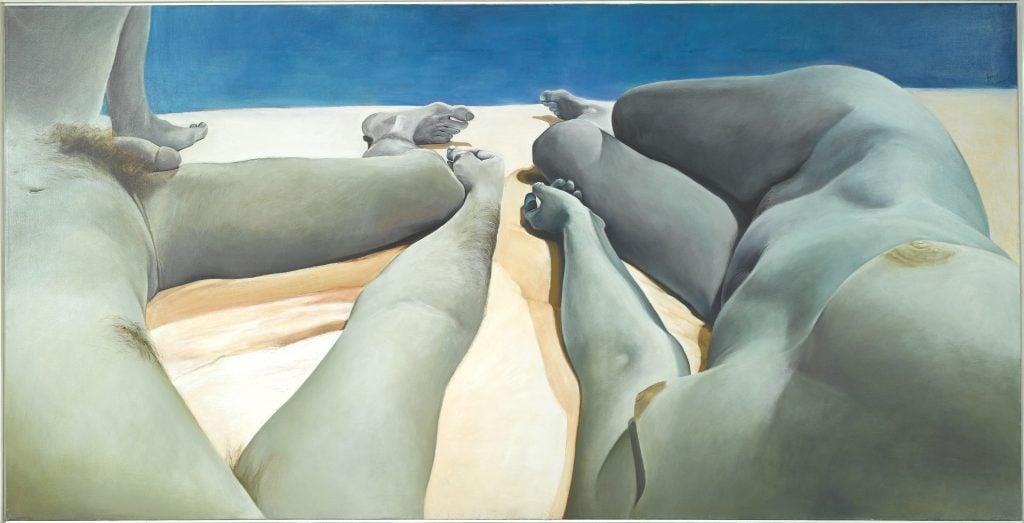Books
‘I Wanted a Real Person to Be Seen’: Joan Semmel on Her 60-Year Career Painting the Female Form—for the Female Gaze
Read an excerpt from the book "New Waves: Contemporary Art and the Issues Shaping Its Tomorrow."

Read an excerpt from the book "New Waves: Contemporary Art and the Issues Shaping Its Tomorrow."

Marta Gnyp

This interview has been excerpted from the recent collection New Waves: Contemporary Art and the Issues Shaping Its Tomorrow (September 2021, Skira Publishers), in which art historian Marta Gnyp interviews some of the world’s leading curators, artists, and collectors.
How did you come to abstraction?
At Cooper Union. Some of the instructors where deeply involved in the Ab-Ex experiment at that point. My whole education at Cooper Union was very much involved in the whole philosophy of Abstract Expressionism, of the gestural art, the expressivity of it and so on.
With the Ab-Ex American specialization you became successful in Spain.
True. I showed at the best gallery there in Madrid. I have traveled to South America with a big show of 35 paintings to the Museum of Plastic Arts in Montevideo in Uruguay, from there it went to the Bonino gallery in Buenos Aires, and I was also scheduled to do something in Brazil, but I opted out of that because I was advised that it would be difficult to get my work back out.
You had a career as a woman artist.
Yes, I was a novelty. Being an American woman making art was a sheer novelty. It gave me an identity immediately. I didn’t get lost in the crowd, so to speak. It meant that I had visibility and respect, but I wasn’t part of their network system. I was friends with Spanish artists. A lot of them came by when I was leaving to give me a party, so it was a good experience all around for me, but I was always an outsider.
Did you like to paint abstract?
Oh yeah, I loved to. I think that’s who I was. Abstraction was where I placed myself and that was the way I worked. I didn’t think that I could do anything else, or that I should do anything else. When I came back to New York, I had a real problem of relating to the kind of work that was being done here at that time. It was no longer Abstract Expressionism, but what they called Color Field painting. I really couldn’t relate to that at all. I also became very passionately involved in the political situation of women in the art world and in the world in general.
One more question about abstraction: have you ever considered to go back to abstraction?
I play with it. I utilize it in my work, I think abstractly and conceptualize a painting in the way I’d put a mark down. All of those things come to me instinctively through the way I always worked as an abstract artist. I don’t separate the two things in my mind. I never felt myself a figurative artist or a realist artist, the two classifications where I could fit. I never experienced my work as figurative; I never thought about being representational as being important, but I thought about the figure as an object—as an icon rather than as representation of any reality.
Perhaps this is why your paintings are so powerful, because it’s really about the color, about the form and about the image as such.
That’s how I thought about it. The reason that I came to work that way, was because I wanted the work to relate to what my passion was at that time, which was to change the way things were for women like me.
Now we come to the limits of abstraction that actually can never really carry a message . . .
They couldn’t carry any messages at all, but I never wanted the work to be pedantic or propagandistic. I never wanted to be telling you what you have to do. Who knows? It wasn’t even a narrative. It carried a message, but not in that traditional way.
I understand. What had changed you? You were a successful abstract painter, then you went back to New York and became determined to fight for the women’s case and connected with feminist groups.
Well, first with the political groups in general; there was a whole group called the Art Workers’ Coalition in New York. I met a lot of the artists there, many of whom I had not known before. There were all kinds of discussions and panels and talks about all kinds of things very deeply connected to the political movements of the time. The reasons for the connection to the women’s movement were much more personal. That had to do with my own struggles as a woman, freeing myself from the necessities conforming to the woman’s role socially. At that time—don’t forget this was 1970s—things were still difficult for women. You can’t imagine the difference between how it was then and how it is now.
I cannot.
It was different in every way: professionally and personally, in family, in work relationships and political relationships. I had to rethink my relationship to myself and to the world in order to become an artist in that environment because it was so constrictive for women.

Joan Semmel, Aura (2016). Courtesy Alexander Gray Associates, New York. Copyright Joan Semmel/Artists Rights Society, New York.
New York is known today as a very liberal city and so it’s really difficult to imagine that it was so oppressive to women.
Well, I think it was oppressive. First of all, from your background in terms of what the expectations of your family were and how you internalized that. Then, it was restrictive in the art world in terms of what a woman artist was expected, or I should say, was not expected to be.
You were not expected to be certain things. You were not expected to be ambitious. You were not expected to be called a genius. You were not expected to even be confident. You were expected to be a sort of camp follower and serve the man and the art world in various ways, both sexually and physically. There were very few women who were able to break through that.
If we speak about 1970s and we take a woman artist like Lee Krasner, was she an interesting role model?
She was, and she wasn’t, because Lee was a very unhappy woman in many ways, and had served her husband [Jackson Pollock] for how long? She developed his career for him. Even after he died, she devoted her life in so many ways to him. At her own expense, so that I wouldn’t take her as a role model.
You are right. She actually belongs to the tradition of women serving the men first at the expense of their own careers.
That’s exactly what I meant. Elaine de Kooning the same way. They were the role models we had. They worked very hard to get to where they were, where they were at least in a position to be seen as an artist. The women were never seen as being artists who broke any rules or who are leaders in any group.
How did feminist circles work? You met each other, you spoke with each other, you shared certain ideologies—such movements can be also suffocating at a certain moment.
No, it was not suffocating. It was quite the reverse, because there were so many different groups and a lot of explosive, very strong personalities. Women who became professional artists at that time were really courageous; you had to be very strong and very willing to put yourself out there and take risks. We firstly got to know each other in these big political meetings that included men. Then the women broke off because they would never have been taken seriously and formed their own groups; that’s how it began. We used to go around and meet in different studios, each time in somebody else’s studio. We got to see work that was never exhibited, we got to see all kind of wonderful work that none of us could get out, that they couldn’t get exhibited.
Did you discuss each other’s works?
Of course. It was never repressive. It was just the reverse. It became more repressive when the theorists became more active. Back then, we didn’t have words like the male gaze or the woman’s gaze, and that’s how I was working, but I never heard those words, so I never thought of it that way. I thought of my own point of view. It was just a formative time.

Joan Semmel, Skin in the Game (2019). Courtesy of the artist and Alexander Gray Associates.
How did you end up making sexual paintings?
People who had similar ideas grouped together a lot. Some of the artists were into painting and decoration, what they called the decorative movement. People like me, we were more involved in the sexual work. We got to know each other, formed different groups to help each other to move the work, to show the work together, to make it into a movement so that we could get visibility.
Sexual paintings became your territory.
That’s right. You got to know other people working in that area, because it gave you a sense of relativity so that you didn’t go crazy. That was important for that kind of thing. We all did very different things; there were people from performance, like Carolee Schneemann to Hannah Wilke, there were just so many of us. There was no formal group, there was no manifesto, but we had certain areas of the work that could be discussed in similar terms so that we could get visibility that way.
It sounds like a group of fantastic characters.
Those were just the ones that came to my mind because I was particularly friendly with them, but there were many more.
What about painting? Painting at that time was considered a more traditional medium.
Well, mine were paintings. Hannah was the sculptural side and photographs; Carolee was performance, so they were all of those kinds of different approaches. I was involved at the time also in writing and curating.
What did you curate?
A museum show called “Consciousness and Content” at Brooklyn Museum (1977). It was a show of women artists. There were two shows that I curated back then. Don’t forget, back then, women didn’t want to show in all-women’s shows. They felt like it was a negative thing to do. I had to convince people that that’s what we had to do to show the strengths of women rather than to try to fight the kind of constant denigration of our work.
Was there a lot of interest from institutions for your work?
We got a fair amount of attention from the press, but we were never supported by the institutions. There were several people, who were supportive as individuals, but the movement itself was not supported. During the middle of the 1980s there started to be political underground, so to speak, in the feminist movement such as Guerrilla Girls.
Who questioned the role of institutions in discriminating women.
They attacked the institutions; they made it clear that we were being institutionally discriminated against by both the galleries and the museums, and that was why the work could not get any support.
What about galleries? Did you have a representation? Were you selling your paintings?
I never sold much. I sold some. I had a gallery at the time, Lerner Heller Gallery. The self-images sold, the sexual images I wasn’t able to even exhibit at that time.
You were lucky to keep them for now.
Well, I couldn’t get the galleries to show them. Before I had gotten a gallery, I rented a space down on Prince Street in Soho and did a big show of the sexual pieces. It got reviewed very well and it sort of introduced me to the art world in a funny way because it was considered very shocking at that time. That was the first show I did in New York.
How did you make them? If I understood correctly you firstly made the sexual paintings followed by the erotic paintings.
Well, the sexual element was just a title. I needed to name them, so we know what we’re talking about. But they were all what I call the sexual painting, really. The first group came right after when I first left abstraction, so they were more abstract with unrealistic colors and gestural kind of marking. Then, I went to using the photographs and made the more representational realistic paintings. So, I had two groups of sexual paintings, one that came directly from abstraction, and the second where I first started using photographs and started working more realistically. After those paintings, I went to the self-image.

Joan Semmel, Intimacy-Autonomy (1974). Copyright Joan Semmel/Artists Rights Society, New York.
The self-image paintings are extremely exciting. Were you taking photos of yourself and of your partner?
Yes. I took the photos of myself; the pictures with the partner, one or two of them were done by collaging two figures together. I took two separate photographs and then called it Intimacy-Autonomy for instance, where I had two separate photographs that each have their own disappearing point and put it together. I called it Intimacy-Autonomy because that’s what I was looking for in the painting. The others I took with the camera myself, holding it sort of next to my eyes to try to get my point of view. It was a very literal interpretation of how I could show a woman artist from her own point of view.
What was your aim in these works?
I was interested in showing and creating an image that women could respond to as an erotic image without raising issues of shame and dismay like pornography does or did. Nowadays it’s different, because now it’s just another entertainment form. But at the time, for women to express their own sexuality was something unheard of.
For women to be able to have desire was still not okay. Women were supposed to not care about sex. They only wanted quote “love,” they wanted romance; they never had a sense of physical desire, this was a different world. I was trying to break down some of that for women to be able to admit their own needs for sex, for women to respond to something that was sexual. To create something visually that would be sexual, but desirous for women, not just projected to the male desire.
Were you analyzing your own thoughts and desires for that?
It was conceptual. I was always looking for, well, how is it different for women? What would make it interesting for women, and not necessarily just for men? When I was making these paintings, it wasn’t about representing my sexuality; I was looking for the triggers that would work for women in general. Obviously, the thought that all women would think the same way is absurd. Different women have different needs, different desires, different points of view, but as a young person at that time, I was going to change the world.
Rightly so. As you said, family was also part of the oppression system unwillingly. How did you get rid of shame that could be imposed on a young woman when showing sexual works?
I don’t know how I got rid of it, but I think that my own experience of first being hospitalized and alone and being in a situation that was that extreme forced me to think about certain things. Then leaving home and going to a foreign country, I was separated from all of those familial kinds of inhibitions, as there was nobody there to tell me how I was supposed to feel. My mother wasn’t on top of me and my father wasn’t telling me what to do, so I was suddenly free, and there was that. So, there were all of those elements in my own personal life that made it possible for me to become myself. The whole idea that the personal is political was a revelation for me.
How did you formulate this concept in order to make it work in your paintings?
This sexual disinterestedness that was put on us, made it impossible for us to be able to really express ourselves in any way. So that we had to begin there to free ourselves to be able to make the kind of cultural contributions that we would like to make.
You started the self-image series before 1974, which means that you started to photograph your body at the age around 30+ and at that time you were a very beautiful young woman. Did you think at that time already that you were going to photograph yourself through your whole life?
No, and I never thought of myself as a beautiful woman displaying her beauty. I never conceived of it that way. The reason I used myself in this was that I wanted to make images of women that were not fetishized. All I saw on the newsstands were images of pin-up kind of women. I felt that it was a false image; it was a commercialized image of selling women’s bodies. I wanted women to be seen in a way that they really were, and with all the imperfections that were there. I wanted to show that the kind of advertising and movies and everything that gave women images of themselves were false and made them always feel inferior and not good enough.
Don’t you think that some women also enjoyed being fetishized?
There wasn’t a woman that didn’t look in the mirror and say, oh, I’m too big here, or too small. They wouldn’t say that if they were the Barbie doll image that was given to us. When I took pictures of myself, it wasn’t that I felt that I was a beautiful woman that wanted to have my beauty displayed as a seductive image; just the reverse. I wanted a real person to be seen, a body that was imperfect, a body that was still sensual, even though it was imperfect; it was not a fetishized object that men made of a woman’s body but rather a human person that they could love. They only saw it as that other kind of thing, which I found offensive and also demoralizing to women. The reason that I used my own body was because I did not want to objectify another woman, especially since I was going to be doing women with all their imperfections. And that it would be unfair to somebody else without their permission. Also, I couldn’t afford models at the time, so I was always available.
I wasn’t suggesting that you wanted to display your beauty, but was curious whether you had taken a principal decision already then to photograph yourself through the process of aging. You’ve been making this painting of yourself for 40 years. You have to be extremely courageous to continue because I think that, in our Western societies, we are absolutely not used to see a naked older body.
Well, that came about just naturally in the work. Obviously, I was using my own body and I was getting older. I saw that and I also had to deal with that personally. We all have to deal with that, right? It doesn’t feel great.